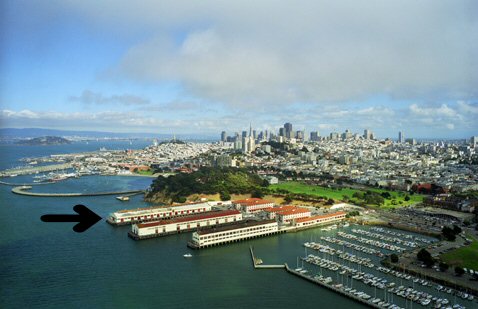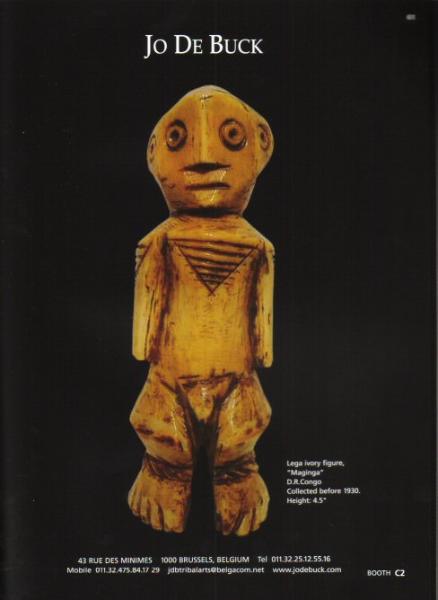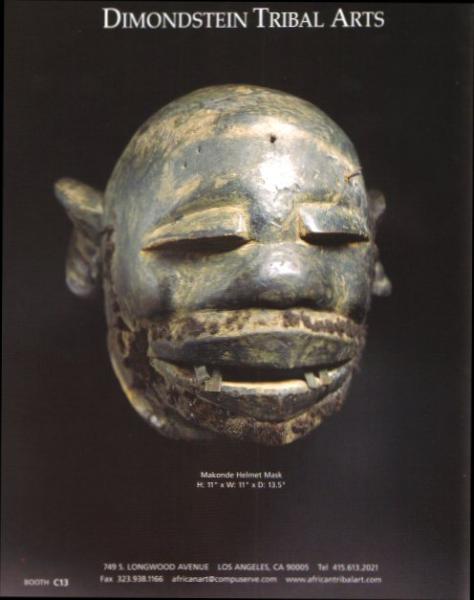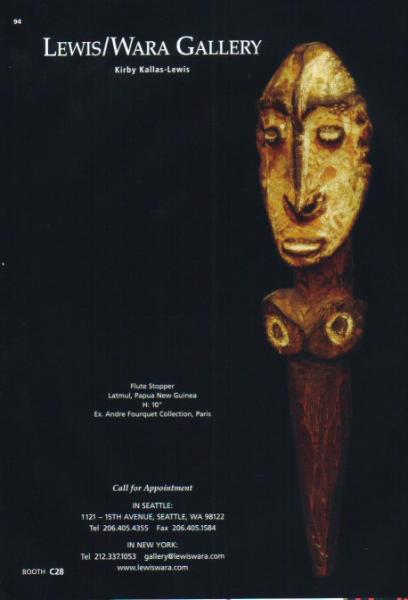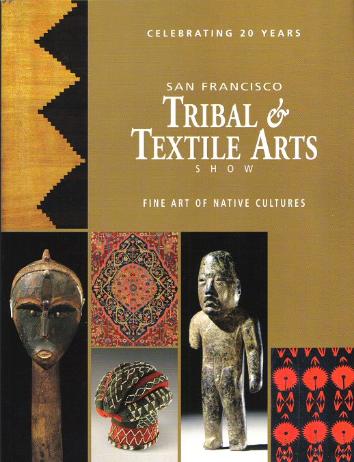
| (Above) The cover of the catalog for the 2006 San Francisco Tribal and Textile Arts Show Below is a little bit of a recap of the show. My original intention was to have a lot more text about my favorite objects each dealer was offering, but it just didn't work out that way. I didn't bring back good notes and I couldn't bring my camera with me so this page didn't turn out like I had envisioned it, but I hope you'll enjoy it anyway. The next show I do this for will have a lot better recap. RAND |
|
| The show is held at the Fort Mason Center on the North side of San Francisco, just West of the Fisherman's Wharf and East of the Presidio. The Tribal and Textile Arts Show was held in the building that the arrow is pointing to in the photo. I attended the show on Friday February 10th, I left the snow and ice in Denver and arrived in San Francisco and it was a beautiful sunny day just like in the photograph above. Since I was only going to be in town for the show for the day I flew in as early as I could. I took the subway to downtown San Francisco and decided I had enough time before the show opened to walk from downtown over to the show, it was about a 2.5 mile walk but it was a nice view and a nice way to enjoy the city. I arrived at the Fort Mason Center right at 11am when the show opened, I really wish that I would have brought my camera with me because even though they state at the entrance to the show that no cameras are allowed, there are plenty of people with cameras in the show anyway. |
| (Above) Floor plan for the show, click on image to see larger version. You walk into the show through the Entrance Garden and that is where the exhibition "To Catch the The & Hold the Spirit: Ritual and Prestige Containers From World Cultures" is set up. It was a nice exhibit and I have placed a link to the images and text from the exhibit at the bottom of this page if you are interested in looking at it. There were LOTS of beautiful objects at the show with prices ranging from a few hundred dollars on up to objects in the high 5 digits and possibly more. Most objects don't have prices readily available on them, you have to inquire about the cost of most things and we all know the old saying, if you have to ask you probably can not afford it, but that isn't always the case as I found out. One thing that I did at this show that I didn't do at the NY Tribal Arts show was to introduce myself to the dealers and hand them a business card, I just didn't feel comfortable doing that in New York and I didn't even have business cards at that time. In NY I kind of laid low and soaked it all in and talked to a few dealers, but never formally introduced myself as a collector and I mainly asked obscure questions about age and provenance on pieces there to see what the answers were. At the San Francisco show my main goal was to introduce myself and do a little networking and establish some relationships with some of the dealers I didn't already know. I was generally surprised at the reception I got from everyone when I handed them a business card and introduced myself, because most of them were familiar with my website and recognized me from it. It was a nice way to break the ice and I had some really great conversations with quite a few dealers. There were a lot of beautiful objects at the show, but for me the most beautiful objects were a group of headrests from the Boni people of Somalia in Eastern Africa that were being offered by Tribal Gathering London, more about them later in this page. It was a great show in my opinion, and I really enjoyed talking to some of the dealers and looking at the objects they were offering. In some ways going to a show like this puts things into perspective for you, or it gives you a new perspective, it all depends on where you are coming from. I respect these dealers because they keep an inventory of high quality African and Oceanic art on hand for people to select from. They also spend quite a bit of money to travel to and participate in shows like this where people can gather to see a large selection of quality objects. Most of these dealers have large overheads to take care of, and that is factored into the price of the objects, but generally the objects were of really high quality and really great examples of objects of their type. It was a very long day for me, I flew into San Francisco at 8 in the morning and flew back out at 8:30 that night, all in all it was a great day for me and a really good experience and I am glad that I was able to make it to the show this year. Since I couldn't / didn't take photos at the show, I have scanned some of the pages in the show catalog to give you examples of some of the objects that were at the show. Most of them are dealers that I have relationships with or dealers that I met at the show that I enjoyed. I wish I would have been able to take some photos, but I hope you will enjoy the virtual tour of the show I put together below from what I had to work with. |
| Click on any image if you want to see larger version My first stop was Gallery DeRoche run by Dave DeRoche. I met Dave at the 2005 NY Tribal Arts Show and enjoyed visiting with him. Dave had a nice mix of African and Oceanic objects in his booth and he was sharing his space with Jo De Buck from Brussels, Belgium. Both Dave DeRoche and Jo De Buck had a nice selection of objects. I did get to see the little Lega ivory figure in the photo above, I think the asking price was around $12,000 but it could have been higher because I can't remember exactly, it stated it was collected before 1930. There were many objects in the booth that were visually more appealing than the 2 objects above that were listed in the catalog. |
| The next stop on the path was Jeffrey Meyers and Earl W Duncan with Meyers & Duncan. They seemed to mainly specialize in NW Coast Indian art, which is also another area that I love. They had a very nice selection of shaman rattles like the one that was displayed in the catalog pictured above. They had a spectacular one that was a wolf rattle that I really loved that I wished I was able to take a photograph of, I have never seen a wolf rattle and this one was old and amazing. |
| Next stop was the Joel Cooner Gallery from Dallas Texas. I met Joel at the NY Tribal Arts Show in 2005 and I talked some with him then, but I didn't talk to him at the San Francisco show. Joel usually has a nice selection of objects and a few that were in the show were ones that he had displayed at the New York show in 2005. Even though his things were nice, nothing in his booth really stood out to me. He always manages to get prime booth space though, last year he was in the entrance to the NY show and this time he was right off of the sculpture garden and restaurant in the middle of the show. |
| Next on the path was Dimondstein Tribal Arts. This was one of the galleries that I wanted to make a point to stop by and introduce myself to. I met Joshua Dimondstein and he was very nice and had a nice selection of objects presented for the show. My conversation with him was interrupted when some of his good clients came into his booth, but I enjoyed meeting him. |
| Next was the Lewis/Wara Gallery that mainly carries very nice Oceanic art and is owned by Kirby Lewis. Kirby is great, and I deal with him on some Oceanic art from time to time when I have people who are interested in Oceanic objects. He always has an incredible selection of objects, and he is a very nice, knowledgeable and friendly person. |
| Next was Tribalmania, owned by Michael Auliso. I have emailed back and forth with Michael from time to time and I really enjoy reading his recaps of the various shows that he participates in or goes to and also the interviews he does with other dealers and collectors. He carries a few African objects but mainly focuses on Oceanic art. He had an incredible carving of a snake in his booth that I wish that I had a photograph of. Very nice guy and he had some interesting objects being offered. |
| Next stop was Kip McKesson African art. It turns out that I had met Kip many years ago in Denver when he was here visiting and stopped in an African art gallery that I worked at part time. Kip had some very nice objects on display, including the wonderful headrest from the Boni people of Somalia pictured above that he featured in the catalog. |
| Next was Tad Tribal Art of Santa Fe, New Mexico. I had never heard of him or his gallery until this show. I go to Santa Fe a couple times a year and next time I go I will make it a point to stop in his gallery. He had a lot of really great objects in his booth and the Pende mask in that he featured in the catalog was very nice. |
| Next was Alain Lecomte of Paris. I saw him at the NY Tribal Arts show in May of 2005 but I didn't meet him then. At this show I introduced myself and he grabbed me by the shoulders and told me that he knew me well from my website. He was incredibly nice and had some really great objects in his booth. He had a Lobi maternity and a Lobi Ti Puo figure that were both really great, and it was hard for me to leave the show without one of them. It did make me appreciate the Lobi figures in my collection quite a bit more though. |
| Next was Giltsoff Gallery. John Giltsoff was incredibly nice and had some very nice African and Oceanic objects in his booth. I had a really great conversation with him about our mutual passion for African art and I enjoyed his perspective on it all. He also publishes a very nice catalog and he gave me a copy. |
| A little further down was Conru Primitive Art. Kevin Conru and I have emailed back and forth in the past about some Oceanic objects and he told me that he really enjoyed reading about how I got into collecting on my website. He is an incredibly nice person and he had a lot of great objects on display. Michael Auliso with Tribalmania did an interview with Kevin Conru a while back and it's a good interview. If you'd like to read it CLICK HERE, it will open in a new window. |
| Next in the row was James Willis Tribal Art from San Francisco. He had an incredible Chokwe janus staff that I drooled over, as well as many other incredible objects. Herbert M Cole also had a few of his miniature masks and carvings in his booth, you can read more about them later down in this page. |


| Probably the highlight of the show for me was meeting the Flak family from the Flak Gallery in Paris. The were incredibly nice and I really enjoyed talking to them. They have been dealing in the Tribal Art business for about 15 years now, and have been collecting for longer than that. The thing that interests me the most is their passion for American Indian objects, and they have a fantastic selection in their Paris gallery I am told. I grew up in New Mexico and as a kid I spent some time on the Indian reservations and markets and I enjoyed talking to them about that. Their son Julien joined the family business about 4 years ago, and he is an incredibly nice guy and I am sure will carry on the family business for years to come. It was nice to see some younger people involved in these galleries at the show. They had a few nice Lobi pieces in their booth and they share the same passion for Lobi that I do and I am excited to see them in Paris in September of this year when I go to the Parcours des Mondes . |
|
| I walked through the Dalton Somare booth, but I didn't get to talk to anyone. Every time I stopped by there were a lot of people in the booth. They had a really nice display and a lot of nice objects. |
And last, but not least, was Tribal Gathering London. I have talked with the owner, Bryan Reeves, a couple of times over email about his medicine
gourds from Tanzania, and I saw him at the NY Tribal arts show last year in May. He had some really great objects on display in his booth and it really
stood out in the crowd because he mainly deals in Eastern and South African objects, and very nice ones at that. He had a really great selection of small
Tutsi baskets and a couple of incredible maternity figures from Tanzania, but the objects that I fell in love with were the headrests from the Boni people
of Somalia (photo below).
They were the objects in the entire show that captivated me the most. I don't know what it was, because I am usually not that taken by headrests, but
these were beautiful. The intricate designs on them were incredible and so was the old warn patina on the wood. I was immediately drawn to the headrest
in the photo below that is 2nd from the right, and I loved holding it in my hands and looking at it. I told Bryan when I left that they were beautiful and I
would love to have all 4 of them, but I wasn't buying anything at the show.
When I got back to Denver, I couldn't stop thinking about them. I started to do a little research on them and found that a couple of the ones he had were
in styles that weren't like any examples I had come across, especially the one that I liked. Most of the examples I came across were like the headrest on
the right in the photo below. I emailed Bryan to ask him if he still had any of the headrests left from the show and lucky (for me) he still did.
I was interested in the one that I had initially liked, but was concerned that I didn't find any examples for comparison. I was also interested in the headrest
on the right which was like the few examples I had found.
He said the one that I had liked is a really rare form of headrest from this region. From his experience, a lot come out without any decoration or in bad
condition, there would only be 1 in 1000 headrests like the one I liked. He said that over the years they have been extremely difficult to get, especially
top quality ones. He thought that the severe drought in that region was the reason why they are now surfacing, but like other pieces in the past this only
lasts for a short time and then they disappear again.
This information further enforced my initial attraction to that particular headrest and I ended up purchasing it.
There is a link below, underneath the photograph of the one I purchased, to the page on my website that I created for it. If you have a Somali or Boni
headrest in your collection, I'd love to see photos of it and possibly put it on the page on my website if you'd like! Just email me.
gourds from Tanzania, and I saw him at the NY Tribal arts show last year in May. He had some really great objects on display in his booth and it really
stood out in the crowd because he mainly deals in Eastern and South African objects, and very nice ones at that. He had a really great selection of small
Tutsi baskets and a couple of incredible maternity figures from Tanzania, but the objects that I fell in love with were the headrests from the Boni people
of Somalia (photo below).
They were the objects in the entire show that captivated me the most. I don't know what it was, because I am usually not that taken by headrests, but
these were beautiful. The intricate designs on them were incredible and so was the old warn patina on the wood. I was immediately drawn to the headrest
in the photo below that is 2nd from the right, and I loved holding it in my hands and looking at it. I told Bryan when I left that they were beautiful and I
would love to have all 4 of them, but I wasn't buying anything at the show.
When I got back to Denver, I couldn't stop thinking about them. I started to do a little research on them and found that a couple of the ones he had were
in styles that weren't like any examples I had come across, especially the one that I liked. Most of the examples I came across were like the headrest on
the right in the photo below. I emailed Bryan to ask him if he still had any of the headrests left from the show and lucky (for me) he still did.
I was interested in the one that I had initially liked, but was concerned that I didn't find any examples for comparison. I was also interested in the headrest
on the right which was like the few examples I had found.
He said the one that I had liked is a really rare form of headrest from this region. From his experience, a lot come out without any decoration or in bad
condition, there would only be 1 in 1000 headrests like the one I liked. He said that over the years they have been extremely difficult to get, especially
top quality ones. He thought that the severe drought in that region was the reason why they are now surfacing, but like other pieces in the past this only
lasts for a short time and then they disappear again.
This information further enforced my initial attraction to that particular headrest and I ended up purchasing it.
There is a link below, underneath the photograph of the one I purchased, to the page on my website that I created for it. If you have a Somali or Boni
headrest in your collection, I'd love to see photos of it and possibly put it on the page on my website if you'd like! Just email me.
|
|
|
| Pictured above is the Boni headrest that I purchased from Tribal Gathering London. CLICK HERE to go to the page on my website to see additional photos and information of this really great headrest, link will open in a new window. |
| I also had the pleasure of meeting Terry Sasser, who is an African art collector and a member of the African Arts and Culture Discussion Group. We had talked the week before the show and he said he was going to be at the show with his friend Herbert M. Cole (Aka Kofi Cole) on Friday and we said that we would try and meet up with each other at the show. I had lunch with Terry and Herbert and a friend of theirs, and then I walked around the show with them for a little bit. Herbert M Cole has been studying African art for over 40 years now and teaching African art at the University of California Santa Barbara, and has published several books as well as many articles in the African Arts publications over the years and it was a real pleasure to meet him and watch him look at the various objects in the booths of the dealers at the show. His major publications include Icons: Ideals and Power in the Art of Africa, 1989; Igbo Arts: Community and Cosmos, 1984 (with C.C. Aniakor) and The Arts of Ghana, (D.H. Ross), 1977. Below are links to various articles that he wrote for the African Arts publication: http://mitpress.mit.edu/catalog/author/default.asp?aid=23773 He has recently started carving miniature African masks and statues and I got to see a few of his carvings at the show and they are fantastic! Below is a link to his website for his miniature carvings (link will open in a new window) http://koficoleart.com/index.html Below are just a few examples of the miniature masks and statues he carves, I think they're great! |




| Pretty incredible considering they are only 2 or 3 inches high at most |
|
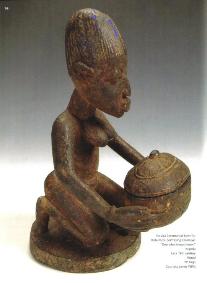


| Rand African Art home page |
